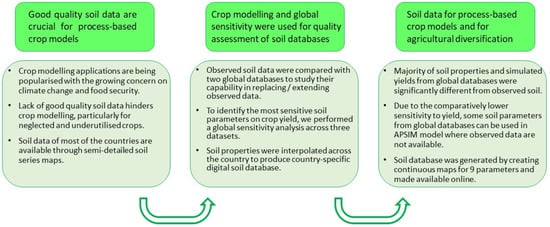Basic Soil Data Requirements for Process-Based Crop Models as a Basis for Crop Diversification
Abstract
1. Introduction
2. Materials and Methods
2.1. Study Area
2.2. Observed Soil Data
2.3. Global Soil Data
2.4. Calculations and Estimation of Missing Parameters
2.5. Yield Simulations
2.5.1. Crop
2.5.2. Crop Model
2.5.3. APSIM Simulations
Climate Data
2.6. Global Sensitivity Analysis
2.7. Interpolation and Mapping
2.8. Evaluation
3. Results
3.1. Comparison of Soil Properties in Different Climatic Zones
3.2. Simulated Rice Yield
3.3. Sensitivity of Rice Yield to Soil Parameters
3.4. Interpolated Maps
4. Discussion
5. Conclusions
Supplementary Materials
Author Contributions
Funding
Conflicts of Interest
Appendix A
| Geostatistics Methods | Neighbourhood Types | Semivariogram Types/Kernel Function/General Properties | RMSE | |||||
|---|---|---|---|---|---|---|---|---|
| 0–5 cm | 5–15 cm | 15–30 cm | 30–60 cm | 60–100 cm | ||||
| pH | EBK | Smooth Circular | Linear | 0.770 | 0.756 | 0.848 | 1.273 | 1.500 |
| OC | EBK | Standard Circular | Linear | 2.649 | 2.620 | 2.616 | 2.185 | 1.651 |
| BD | EBK | Standard Circular | Linear | 0.184 | 0.274 | 0.281 | 0.390 | 0.668 |
| CEC | EBK | Standard Circular | Linear | 14.949 | 14.765 | 14.301 | 12.761 | 8.177 |
| DUL | EBK | Standard Circular | Linear | 0.090 | 0.086 | 0.077 | 0.088 | 0.115 |
| LL15 | EBK | Standard Circular | Linear | 0.082 | 0.078 | 0.070 | 0.074 | 0.091 |
| Clay | RBF | Standard | Completely Regularised Spline | 10.838 | 10.694 | 11.678 | 13.377 | 14.735 |
| Sand | RBF | Standard | Completely Regularised Spline | 15.970 | 15.861 | 16.482 | 20.565 | 21.368 |
| Silt | RBF | Standard | Completely Regularised Spline | 8.159 | 8.151 | 8.688 | 8.717 | 8.685 |
References
- Karunaratne, A.S.; Walker, S.; Ruane, A.C. Modelling Bambara groundnut yield in Southern Africa: Towards a climate-resilient future. Clim. Res. 2015, 65, 193–203. [Google Scholar] [CrossRef]
- Holzworth, D.P.; Huth, N.I.; deVoil, P.G.; Zurcher, E.J.; Herrmann, N.I.; McLean, G.; Chenu, K.; van Oosterom, E.J.; Snow, V.; Murphy, C.; et al. APSIM—Evolution towards a new generation of agricultural systems simulation. Environ. Model. Softw. 2014, 62, 327–350. [Google Scholar] [CrossRef]
- Chisanga, C.B.; Phiri, E.; Chinene, V.R.N. Climate change impact on maize (Zea mays L.) yield using crop simulation and statistical downscaling models: A review. Sci. Res. Essays 2017, 12, 167–187. [Google Scholar] [CrossRef]
- Madegwa, Y.M. Modelling Nutrient Dynamics and Yield of Finger Millet (Eleusine Coracana) in Semi-Arid Eastern Kenya, Using the Agricultural Production Systems Simulator Model (APSIM). Master’s Thesis, University of Nairobi, Nairobi, Kenya, 2015. [Google Scholar]
- Li, X.; Zhu, C.; Wang, J.; Yu, J. Chapter six—Computer Simulation in Plant Breeding. In Advances in Agronomy; Sparks, D.L., Ed.; Academic Press: Cambridge, MA, USA, 2012; Volume 116, pp. 219–264. [Google Scholar]
- Jahanshiri, E.; Mohd Nizar, N.M.; Tengku Mohd Suhairi, T.A.S.; Gregory, P.J.; Mohamed, A.S.; Wimalasiri, E.M.; Azam-Ali, S.N. A Land Evaluation Framework for Agricultural Diversification. Sustainability 2020, 12, 3110. [Google Scholar] [CrossRef]
- Mabhaudhi, T.; Modi, A.T.; Beletse, Y.G. Parameterisation and evaluation of the FAO-AquaCrop model for a South African taro (Colocasia esculenta L. Schott) landrace. Agric. For. Meteorol. 2014, 192, 132–139. [Google Scholar] [CrossRef]
- Sharda, V.; Handyside, C.; Chaves, B.; McNider, R.T.; Hoogenboom, G. The impact of spatial soil variability on simulation of regional maize yield. Trans. Asabe 2017, 60, 2137–2148. [Google Scholar] [CrossRef]
- Folberth, C.; Skalský, R.; Moltchanova, E.; Balkovič, J.; Azevedo, L.B.; Obersteiner, M.; van der Velde, M. Uncertainty in soil data can outweigh climate impact signals in global crop yield simulations. Nat. Commun. 2016, 7, 11872. [Google Scholar] [CrossRef]
- Woli, P.; Paz, J.O.; Hoogenboom, G.; Garcia y Garcia, A.; Fraisse, C.W. The ENSO effect on peanut yield as influenced by planting date and soil type. Agric. Syst. 2013, 121, 1–8. [Google Scholar] [CrossRef]
- Kuleshov, Y. Use of Remote Sensing Data for Climate Monitoring in WMO Regions II and V (Asia and the South-West Pacific); World Meteorological Organization: Geneva, Switzerland, 2017. [Google Scholar]
- Han, E.; Ines, A.V.M.; Koo, J. Development of a 10-km resolution global soil profile dataset for crop modeling applications. Environ. Model. Softw. 2019, 119, 70–83. [Google Scholar] [CrossRef]
- Hengl, T.; MacMillan, R.A. Predictive Soil Mapping with R; OpenGeoHub foundation: Wageningen, The Netherlands, 2019; ISBN 978-0-359-30635-0. [Google Scholar]
- Nachtergaele, F.; van Velthuizen, H.; Verelst, L.; Batjes, N.; Dijkshoorn, K.; van Engelen, V.; Fischer, G.; Jones, A.; Montanarella, L.; Petri, M.; et al. Harmonized World Soil Database; Food and Agriculture Organization of the United Nations: Rome, Italy, 2009. [Google Scholar]
- Batjes, N. ISRIC-WISE Derived Soil Properties on a 5 by 5 Arc-Minutes Global Grid (Ver. 1.2); ISRIC: Wageningen, The Netherlands, 2012; p. 56. [Google Scholar]
- Ribeiro, E.; Batjes, N.H.; van Oostrum, A.J.M. World Soil Information Service (WoSIS)—Towards the Standardization and Harmonization of World Soil Data; ISRIC—World Soil Information: Wageningen, The Netherlands, 2018; p. 151. [Google Scholar]
- Batjes, N.H.; Ribeiro, E.; van Oostrum, A. Standardised soil profile data to support global mapping and modelling (WoSIS snapshot 2019). Earth Syst. Sci. Data 2020, 12, 299–320. [Google Scholar] [CrossRef]
- Hengl, T.; de Jesus, J.M.; Heuvelink, G.B.M.; Gonzalez, M.R.; Kilibarda, M.; Blagotić, A.; Shangguan, W.; Wright, M.N.; Geng, X.; Bauer-Marschallinger, B.; et al. SoilGrids250m: Global gridded soil information based on machine learning. PLoS ONE 2017, 12, e0169748. [Google Scholar] [CrossRef] [PubMed]
- Hengl, T.; Collins, T.N.; Wheeler, I.; MacMillan, R.A. Everybody Has a Right to Know What’s Happening with the Planet: Towards a Global Commons. Available online: http://doi.org/10.5281/zenodo.3274294 (accessed on 21 September 2020).
- Kim, K.S.; Yoo, B.H.; Shelia, V.; Porter, C.H.; Hoogenboom, G. START: A data preparation tool for crop simulation models using web-based soil databases. Comput. Electron. Agric. 2018, 154, 256–264. [Google Scholar] [CrossRef]
- Jones, J.W.; Hoogenboom, G.; Porter, C.H.; Boote, K.J.; Batchelor, W.D.; Hunt, L.A.; Wilkens, P.W.; Singh, U.; Gijsman, A.J.; Ritchie, J.T. The DSSAT cropping system model. Eur. J. Agron. 2003, 18, 235–265. [Google Scholar] [CrossRef]
- Varella, H.; Guérif, M.; Buis, S. Global sensitivity analysis measures the quality of parameter estimation: The case of soil parameters and a crop model. Environ. Model. Softw. 2010, 25, 310–319. [Google Scholar] [CrossRef]
- Vanuytrecht, E.; Raes, D.; Willems, P. Global sensitivity analysis of yield output from the water productivity model. Environ. Model. Softw. 2014, 51, 323–332. [Google Scholar] [CrossRef]
- Manna, P.; Bonfante, A.; Perego, A.; Acutis, M.; Jahanshiri, E.; Ali, S.A.; Basile, A.; Terribile, F. LANDSUPPORT DSS Approach for Crop Adaptation Evaluation to the Combined Effect of Climate Change and Soil Spatial Variability. Geophys. Res. Abstr. 2019, 21, 15457. [Google Scholar]
- Punyawardena, B.V.R. Precipitation of Sri Lanka and Agro-Ecological Regions; Agriculture Press: Peradeniya, Sri Lanka, 2008. [Google Scholar]
- Mapa, R.B. Soil research and soil mapping history. In The Soils of Sri Lanka; Mapa, R.B., Ed.; Springer Nature: Cham, Switzerland, 2020; pp. 1–11. [Google Scholar]
- Mapa, R.B.; Somasiri, S.; Magarajah, S. Soils of the Wet Zone of Sri Lanka: Morphology, Characterization and Classification: Special Publication No. 1; Soil Science Society of Sri Lanka, Sarvodaya Wishva Lekha: Colombo, Sri Lanka, 1999. [Google Scholar]
- Mapa, R.B.; Dassanayake, A.R.; Nayakekorale, H.B. Soils of the Intermediate Zone of Sri Lanka: Morphology, Characterization and Classification. Special Publication No. 4; Soil Science Society of Sri Lanka, Sarvodaya Wishva Lekha: Colombo, Sri Lanka, 2005. [Google Scholar]
- Mapa, R.B.; Somasiri, S.; Dassanayake, A.R. Soils of the Dry Zone of Sri Lanka: Morphology, Characterization and Classification. Special Publication No. 7; Soil Science Society of Sri Lanka, Sarvodaya Wishva Lekha: Colombo, Sri Lanka, 2010. [Google Scholar]
- Mapa, R.B. Characterization of Soils in the Northern Region of Sri Lanka to Develop a Soil Data Base for Land Use Planning and Environmental Applications; National Research Council of Sri Lanka: Colombo, Sri Lanka, 2016. [Google Scholar]
- Kabała, C.; Musztyfaga, E.; Gałka, B.; Łabuńska, D.; Mańczyńska, P. Conversion of Soil pH 1:2.5 KCl and 1:2.5 H2O to 1:5 H2O: Conclusions for Soil Management, Environmental Monitoring, and International Soil Databases. Pol. J. Environ. Stud. 2016, 25, 647–653. [Google Scholar] [CrossRef]
- Libohova, Z.; Wills, S.; Odgers, N.P.; Ferguson, R.; Nesser, R.; Thompson, J.A.; West, L.T.; Hempel, J.W. Converting pH1:1 H2O and 1:2CaCl2 to 1:5 H2O to contribute to a harmonized global soil database. Geoderma 2014, 213, 544–550. [Google Scholar] [CrossRef]
- Gunarathna, M.H.J.P.; Sakai, K.; Nakandakari, T.; Momii, K.; Kumari, M.K.N.; Amarasekara, M.G.T.S. Pedotransfer functions to estimate hydraulic properties of tropical Sri Lankan soils. Soil Till. Res. 2019, 190, 109–119. [Google Scholar] [CrossRef]
- Dalgliesh, N.; Hochman, Z.; Huth, N.; Holzworth, D. Field Protocol to APSoil Characterisations. Version 4; CSIRO: Black Mountain, Australia, 2016. [Google Scholar]
- Bishop, T.F.A.; McBratney, A.B.; Laslett, G.M. Modelling soil attribute depth functions with equal-area quadratic smoothing splines. Geoderma 1999, 91, 27–45. [Google Scholar] [CrossRef]
- Agstat—Agricultural Statistics; Socio Economics and Planning Centre, Department of Agriculture: Peradeniya, Sri Lanka, 2019.
- Keating, B.A.; Carberry, P.S.; Hammer, G.L.; Probert, M.E.; Robertson, M.J.; Holzworth, D.; Huth, N.I.; Hargreaves, J.N.G.; Meinke, H.; Hochman, Z.; et al. An overview of APSIM, a model designed for farming systems simulation. Eur. J. Agron. 2003, 18, 267–288. [Google Scholar] [CrossRef]
- Gaydon, D.S.; Probert, M.E.; Buresh, R.J.; Meinke, H.; Suriadi, A.; Dobermann, A.; Bouman, B.; Timsina, J. Rice in cropping systems—Modelling transitions between flooded and non-flooded soil environments. Eur. J. Agron. 2012, 39, 9–24. [Google Scholar] [CrossRef]
- Probert, M.E.; Dimes, J.P.; Keating, B.A.; Dalal, R.C.; Strong, W.M. APSIM’s water and nitrogen modules and simulation of the dynamics of water and nitrogen in fallow systems. Agric. Syst. 1998, 56, 1–28. [Google Scholar] [CrossRef]
- Zubair, L.; Nissanka, S.P.; Weerakoon, W.M.W.; Herath, D.I.; Karunaratne, A.S.; Prabodha, A.S.M.; Agalawatte, M.B.; Herath, R.M.; Yahiya, S.Z.; Punyawardhene, B.V.R.; et al. Climate Change Impacts on Rice Farming Systems in Northwestern Sri Lanka. In Series on Climate Change Impacts, Adaptation, and Mitigation; Imperial College Press: London, UK, 2015; Volume 4, pp. 315–352. ISBN 978-1-78326-563-3. [Google Scholar]
- Ruane, A.C.; Goldberg, R.; Chryssanthacopoulos, J. Climate forcing datasets for agricultural modeling: Merged products for gap-filling and historical climate series estimation. Agric. For. Meteorol. 2015, 200, 233–248. [Google Scholar] [CrossRef]
- Lashkari, A.; Salehnia, N.; Asadi, S.; Paymard, P.; Zare, H.; Bannayan, M. Evaluation of different gridded rainfall datasets for rainfed wheat yield prediction in an arid environment. Int. J. Biometeorol. 2018, 62, 1543–1556. [Google Scholar] [CrossRef]
- Ceglar, A.; Toreti, A.; Balsamo, G.; Kobayashi, S. Precipitation over Monsoon Asia: A Comparison of Reanalyses and Observations. J. Clim. 2017, 30, 465–476. [Google Scholar] [CrossRef]
- Gunarathna, M.H.J.P.; Sakai, K.; Kumari, M.K.N.; Ranagalage, M. A Functional Analysis of Pedotransfer Functions Developed for Sri Lankan soils: Applicability for Process-Based Crop Models. Agronomy 2020, 10, 285. [Google Scholar] [CrossRef]
- Sobol, I.M. Sensitivity estimates for nonlinear mathematical models. Math. Modeling Comput. Exp. 1993, 4, 407–414. [Google Scholar]
- Owen, G. Game Theory; Academic Press: New York, NY, USA, 1982. [Google Scholar]
- Roth, A.E. The Shapley Value as a von Neumann-Morgenstern Utility. Econometrica 1977, 45, 657–664. [Google Scholar] [CrossRef]
- Roth, A.E. The Shapley Value: Essays in Honor of Lloyd S. Shapley; Cambridge University Press: Cambridge, UK, 1988. [Google Scholar]
- Gong, X. Towards Understanding Crop Yield Systemic Risk and Its Implication for Crop Insurance Choices. Master’s Thesis, Michigan State University, Ann Arbor, MI, USA, 2019. [Google Scholar]
- Lipovetsky, S.; Conklin, M. Analysis of regression in game theory approach. Appl. Stoch. Model. Bus. 2001, 17, 319–330. [Google Scholar] [CrossRef]
- Owen, A.B.; Prieur, C. On Shapley Value for Measuring Importance of Dependent Inputs. Siam-Asa J. Uncertain. 2017, 5, 986–1002. [Google Scholar] [CrossRef]
- R Core Team. R: A Language and Environment for Statistical Computing; R Foundation for Statistical Computing: Vienna, Austria, 2013. [Google Scholar]
- Broto, B.; Bachoc, F.; Depecker, M.; Martinez, J.M. Sensitivity indices for independent groups of variables. Math. Comput. Simul. 2019, 163, 19–31. [Google Scholar] [CrossRef]
- Shapiro, S.S.; Wilk, M.B. An Analysis of Variance Test for Normality (Complete Samples). Biometrika 1965, 52, 591–611. [Google Scholar] [CrossRef]
- Royston, J.P. An Extension of Shapiro and Wilk’s W Test for Normality to Large Samples. J. R. Stat. Soc. C Appl. 1982, 31, 115–124. [Google Scholar] [CrossRef]
- Ahmed, H.; Siddique, M.T.; Iqbal, M.; Hussain, F. Comparative study of interpolation methods for mapping soil pH in the apple orchards of Murree, Pakistan. Soil Environ. 2017, 36, 70–76. [Google Scholar] [CrossRef]
- Li, J.; Heap, A.D. A review of comparative studies of spatial interpolation methods in environmental sciences: Performance and impact factors. Ecol. Inform. 2011, 6, 228–241. [Google Scholar] [CrossRef]
- Yasrebi, J.; Saffari, M.; Fathi, H.; Karimian, N.; Moazallahi, M.; Gazni, R. Evaluation and comparison of Ordinary Kriging and Inverse Distance Weighting methods for prediction of spatial variability of some soil chemical parameters. Res. J. Biol. Sci. 2009, 4, 93–102. [Google Scholar]
- Rodrigues, M.S.; Alves, D.C.; de Souza, V.C.; de Melo, A.C.; Lima, A.M.N.; Cunha, J.C. Spatial interpolation techniques for site-specific irrigation management in a mango orchard. Comun. Sci. 2018, 9, 93–101. [Google Scholar] [CrossRef]
- Sulaeman, Y.; Minasny, B.; McBratney, A.B.; Sarwani, M.; Sutandi, A. Harmonizing legacy soil data for digital soil mapping in Indonesia. Geoderma 2013, 192, 77–85. [Google Scholar] [CrossRef]
- Rathnayake, W.M.U.K.; De Silva, R.P.; Dayawansa, N.D.K. Variability of some important soil chemical properties of rainfed low land paddy fields and its effect on land suitability for rice cultivation. Trop. Agric. Res. 2015, 26, 506. [Google Scholar] [CrossRef]
- Vitharana, U.W.A.; Mishra, U.; Mapa, R.B. National soil organic carbon estimates can improve global estimates. Geoderma 2019, 337, 55–64. [Google Scholar] [CrossRef]
- Botula, Y.D.; Cornelis, W.M.; Baert, G.; Van Ranst, E. Evaluation of pedotransfer functions for predicting water retention of soils in Lower Congo (D.R. Congo). Agric. Water Manag. 2012, 111, 1–10. [Google Scholar] [CrossRef]
- Ryczek, M.; Kruk, E.; Malec, M.; Klatka, S. Comparison of pedotransfer functions for the determination of saturated hydraulic conductivity coefficient. Environ. Prot. Nat. Resour. 2017, 28, 25–30. [Google Scholar] [CrossRef]
- Petropoulos, G.; Wooster, M.J.; Carlson, T.N.; Kennedy, M.C.; Scholze, M. A global Bayesian sensitivity analysis of the 1d SimSphere soil–vegetation–atmospheric transfer (SVAT) model using Gaussian model emulation. Ecol. Model. 2009, 220, 2427–2440. [Google Scholar] [CrossRef]
- Vitharana, U.W.A.; Mapa, R.B. Soil survey, classification and mapping in Sri Lanka: Past, present and future. In Agricultural Research for Sustainable Food Systems in Sri Lanka; Marambe, B., Weerahewa, J., Dandeniya, W.S., Eds.; Springer Nature: Singapore, 2020; Volume 1, pp. 77–100. [Google Scholar]
- Ramcharan, A.; Hengl, T.; Nauman, T.; Brungard, C.; Waltman, S.; Wills, S.; Thompson, J. Soil Property and Class Maps of the Conterminous United States at 100-Meter Spatial Resolution. Soil Sci. Soc. Am. J. 2018, 82, 186–201. [Google Scholar] [CrossRef]
- Pásztor, L.; Laborczi, A.; Bakacsi, Z.; Szabó, J.; Illés, G. Compilation of a national soil-type map for Hungary by sequential classification methods. Geoderma 2018, 311, 93–108. [Google Scholar] [CrossRef]
- Herrick, J.E.; Beh, A.; Barrios, E.; Bouvier, I.; Coetzee, M.; Dent, D.; Elias, E.; Hengl, T.; Karl, J.W.; Liniger, H.; et al. The land-potential knowledge system (landpks): Mobile apps and collaboration for optimizing climate change investments. Ecosyst. Health Sustain. 2016, 2, e01209. [Google Scholar] [CrossRef]
- Zhao, C.; Liu, B.; Xiao, L.; Hoogenboom, G.; Boote, K.J.; Kassie, B.T.; Pavan, W.; Shelia, V.; Kim, K.S.; Hernandez-Ochoa, I.M.; et al. A SIMPLE crop model. Eur. J. Agron. 2019, 104, 97–106. [Google Scholar] [CrossRef]

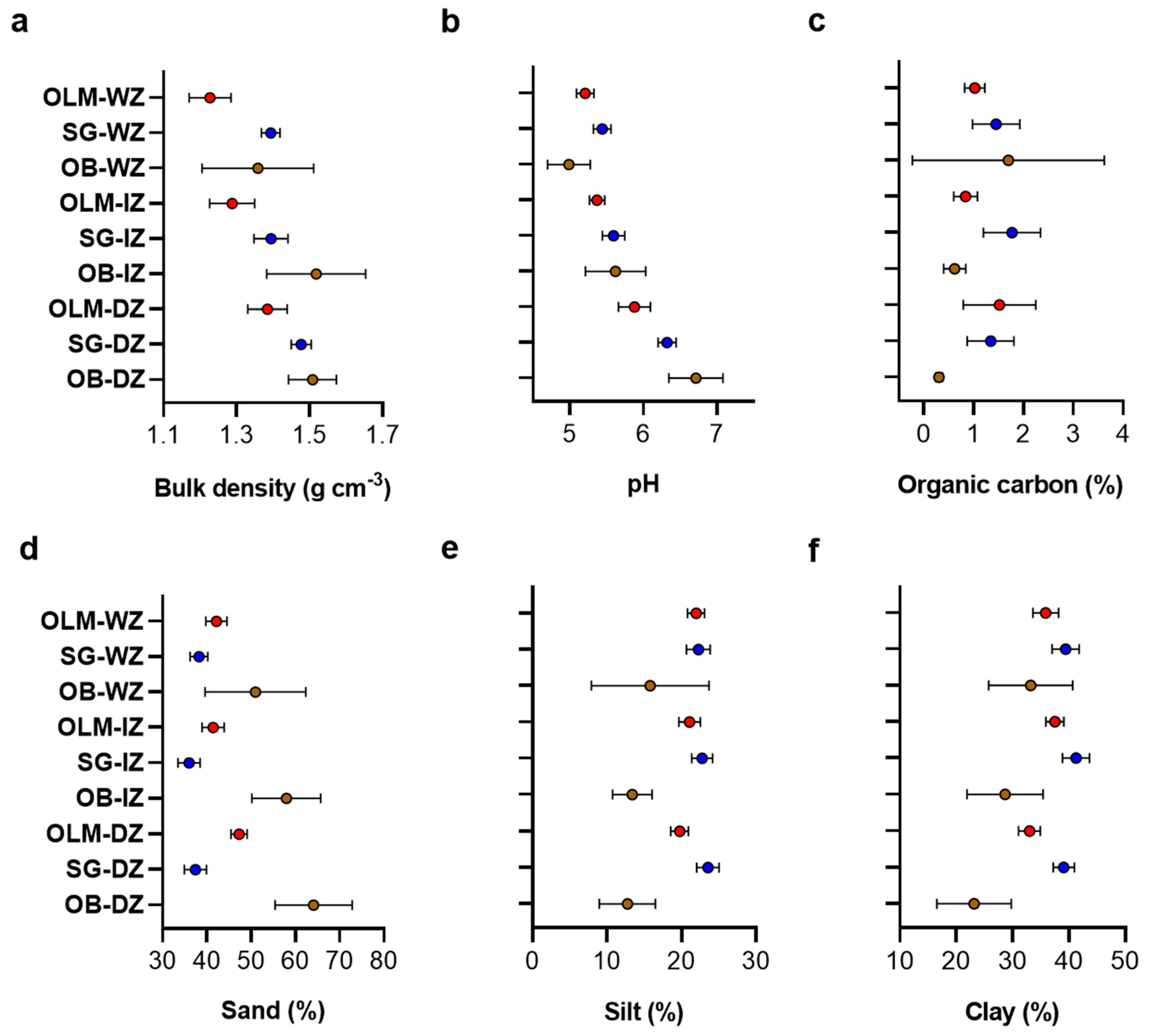
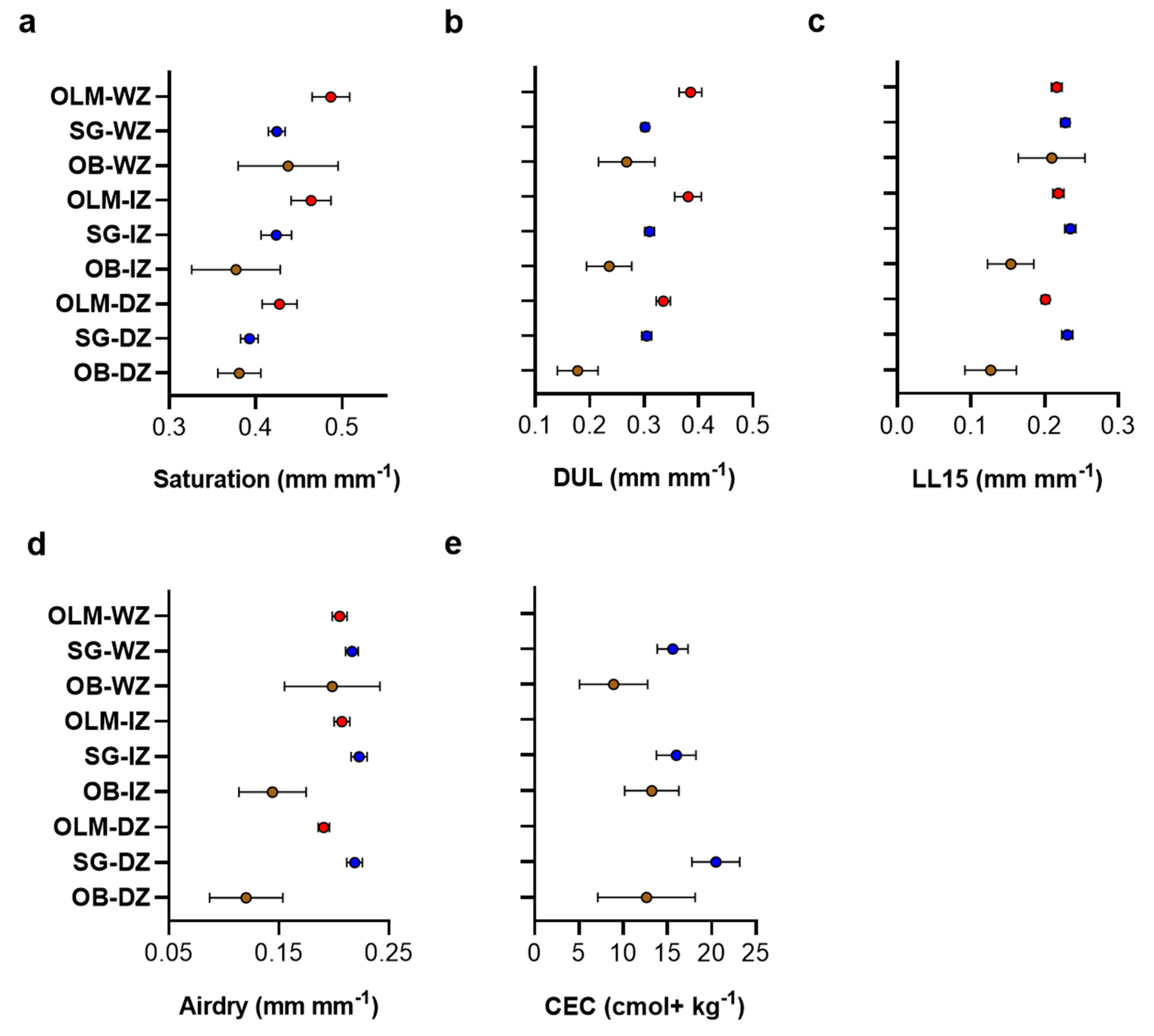
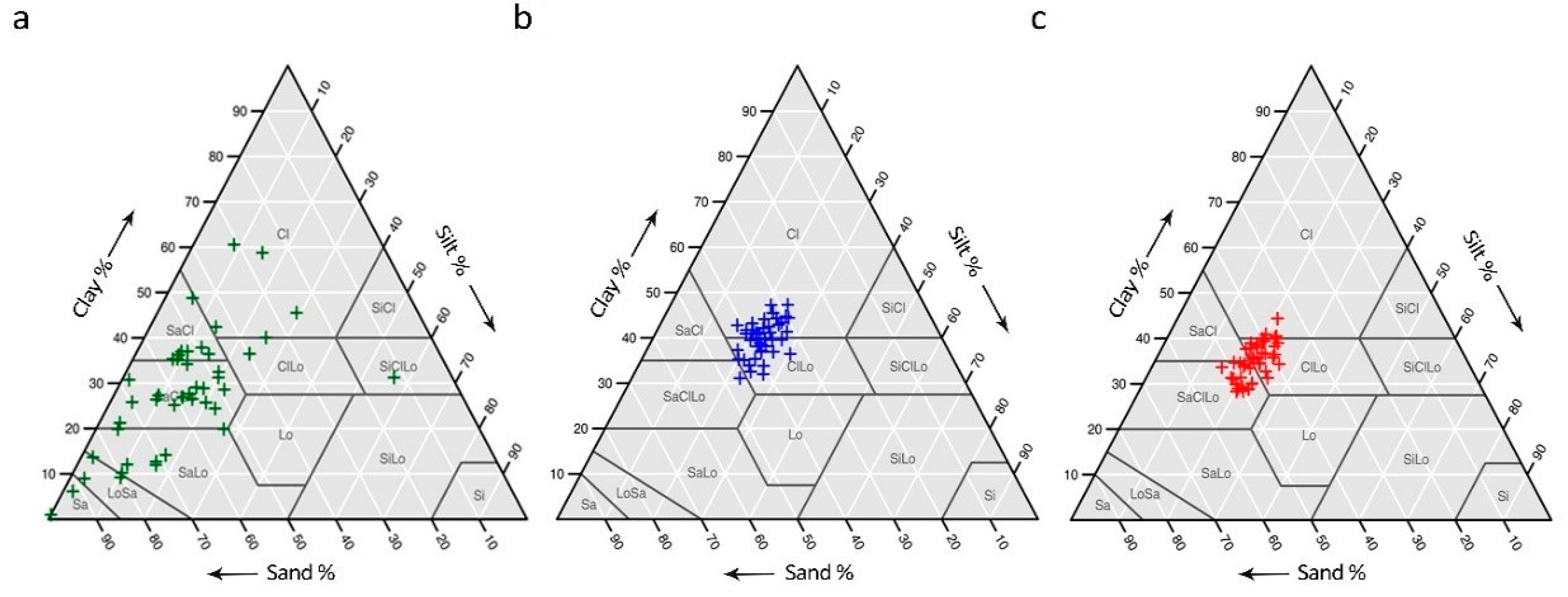
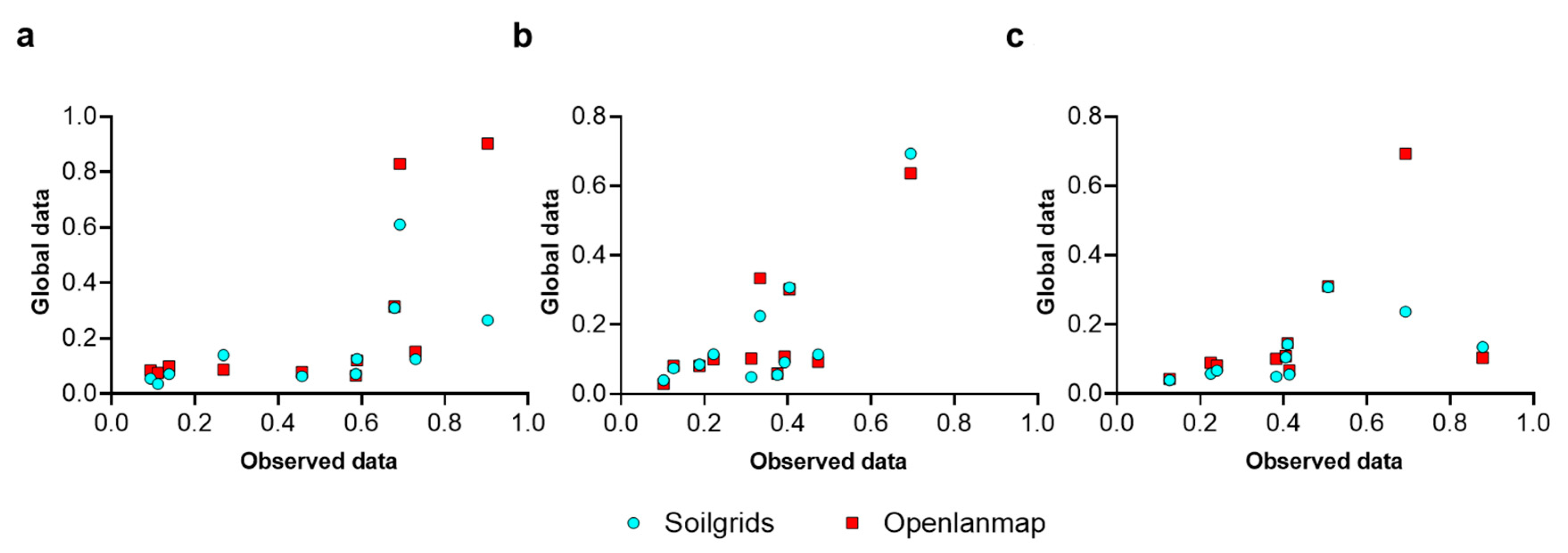


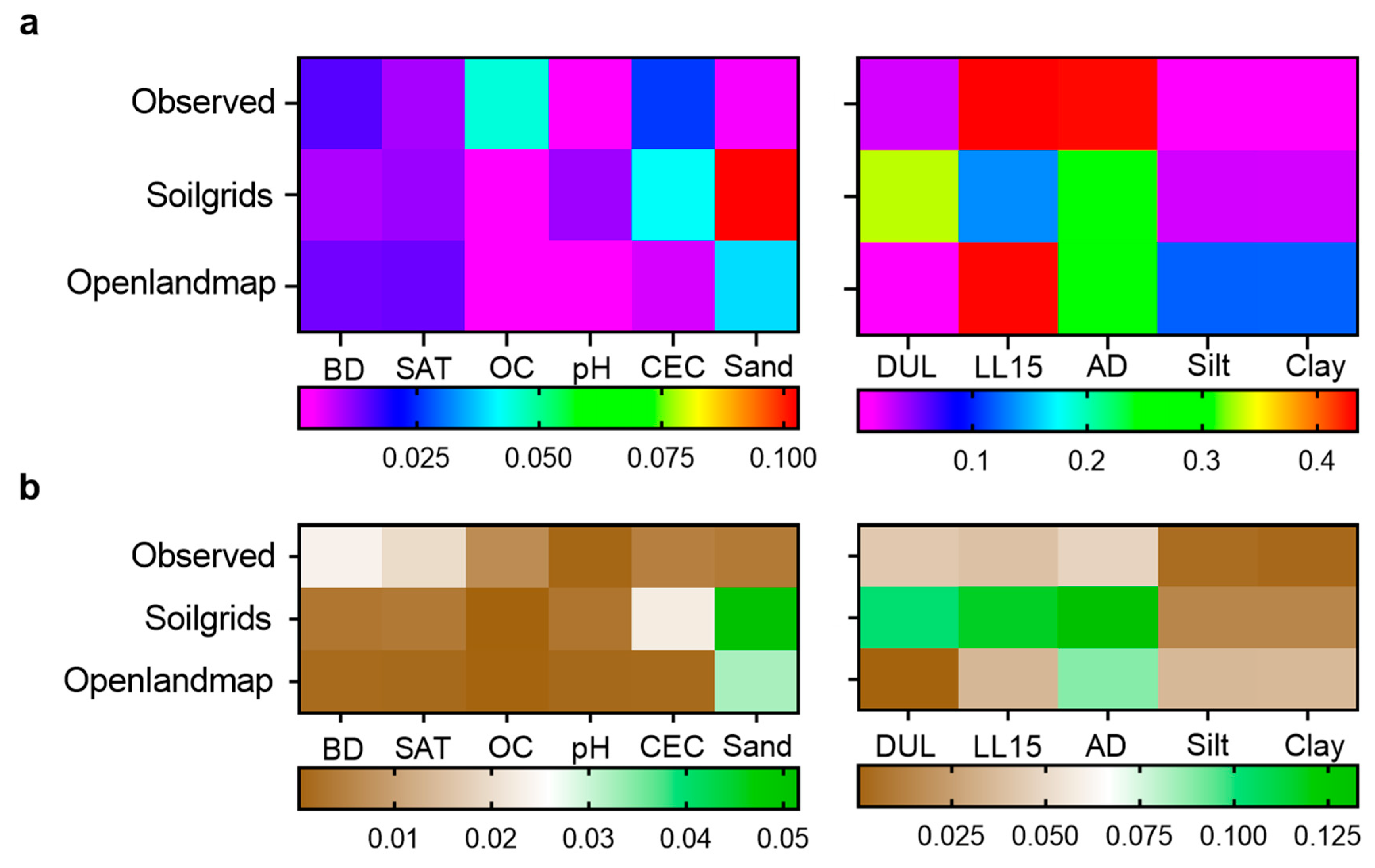
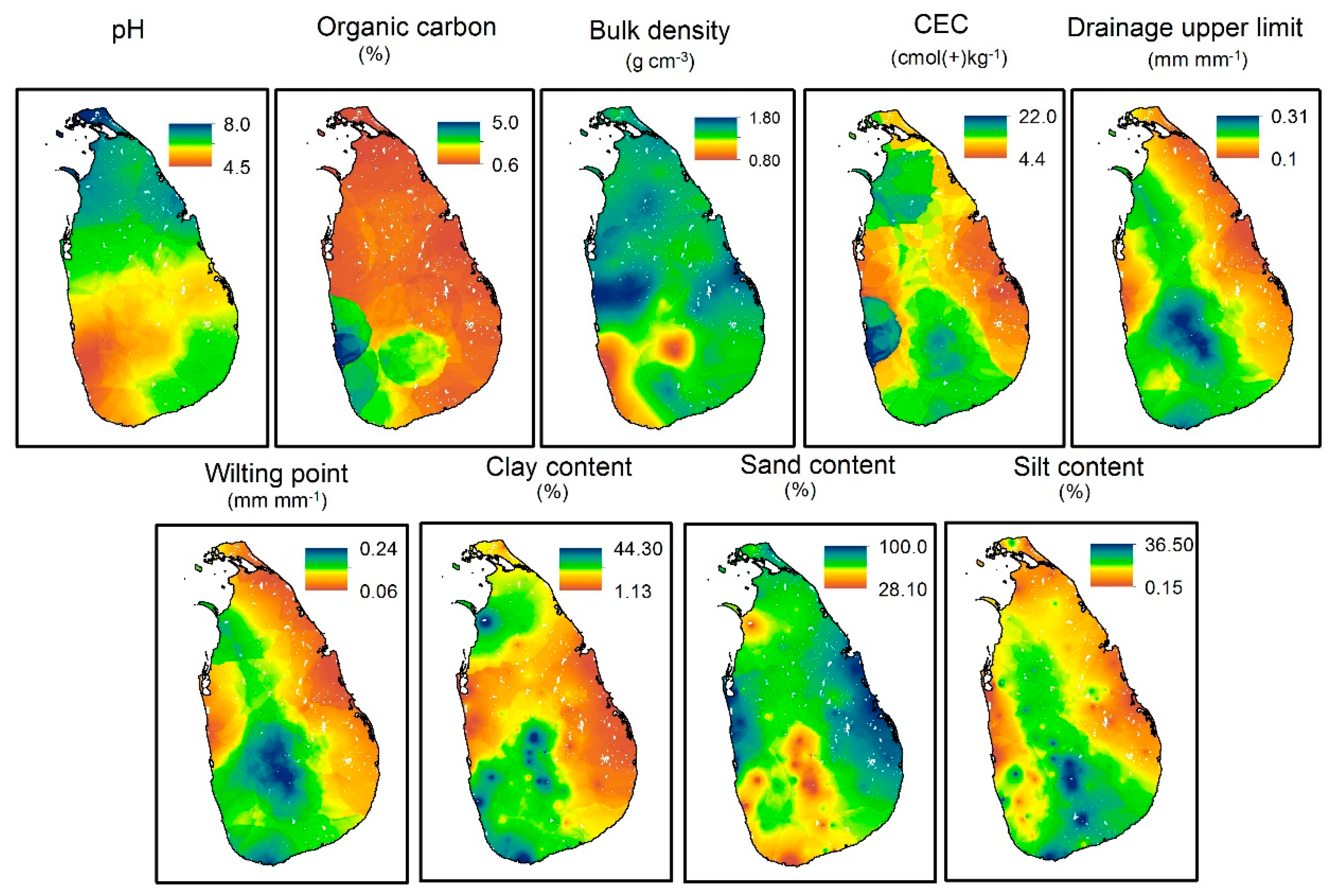
| Parameter | Observed | Soilgrids | Openlandmap | |
|---|---|---|---|---|
| BD (g cm–3) | Mean | 1.43 ± 0.23 | 1.38 ± 0.09 | 1.28 ± 0.13 |
| Range | 0.30–1.82 | 1.08–1.55 | 0.96–1.53 | |
| OC (%) | Mean | 1.13 ± 2.13 | 2.22 ± 1.58 | 1.65 ± 1.23 |
| Range | 0.01–16.81 | 0.00–10.00 | 0.00–6.58 | |
| pH | Mean | 5.79 ± 0.97 | 5.81 ± 0.45 | 5.46 ± 0.44 |
| Range | 2.37–8.27 | 5.09–6.92 | 4.68–6.81 | |
| CEC (cmol(+) kg−1) | Mean | 11.33 ± 8.21 | 18.48 ± 5.07 | - |
| Range | 0.78–51.49 | 10.00–35.00 | - | |
| Sand (%) | Mean | 61.20 ± 19.54 | 38.83 ± 4.84 | 45.54 ± 5.29 |
| Range | 3.70–99.00 | 27.00–50.00 | 33.50–58.12 | |
| Silt (%) | Mean | 13.66 ± 9.59 | 23.51 ± 2.88 | 21.25 ± 2.57 |
| Range | 0.00–62.07 | 16.00–31.00 | 14.50–28.56 | |
| Clay (%) | Mean | 25.13 ± 14.26 | 37.65 ± 4.90 | 33.21 ± 4.92 |
| Range | 1.00–67.35 | 26.00–48.50 | 20.28–46.00 | |
| SAT (mm mm−1) | Mean | 0.409 ± 0.089 | 0.429 ± 0.036 | 0.467 ± 0.049 |
| Range | 0.263–0.836 | 0.365–0.544 | 0.373–0.589 | |
| DUL (mm mm−1) | Mean | 0.220 ± 0.095 | 0.300 ± 0.017 | 0.356 ± 0.041 |
| Range | 0.045–0.423 | 0.261–0.341 | 0.274–0.465 | |
| LL15 (mm mm−1) | Mean | 0.162 ± 0.083 | 0.226 ± 0.015 | 0.206 ± 0.016 |
| Range | 0.017–0.350 | 0.193–0.262 | 0.168–0.242 | |
| AD (mm mm−1) | Mean | 0.129 ± 0.076 | 0.182 ± 0.056 | 0.166 ± 0.052 |
| Range | 0.009–0.350 | 0.096–0.262 | 0.084–0.242 |
| Parameter | Observed vs. Soilgrids | Observed vs. Openlandmap | Soilgrids vs. Openlandmap |
|---|---|---|---|
| RMSE (t ha−1) | 2.02 | 1.69 | 1.00 |
| NRMSE | 0.44 | 0.37 | 0.16 |
| d | 0.23 | 0.27 | 0.43 |
© 2020 by the authors. Licensee MDPI, Basel, Switzerland. This article is an open access article distributed under the terms and conditions of the Creative Commons Attribution (CC BY) license (http://creativecommons.org/licenses/by/4.0/).
Share and Cite
Wimalasiri, E.M.; Jahanshiri, E.; Suhairi, T.A.S.T.M.; Udayangani, H.; Mapa, R.B.; Karunaratne, A.S.; Vidhanarachchi, L.P.; Azam-Ali, S.N. Basic Soil Data Requirements for Process-Based Crop Models as a Basis for Crop Diversification. Sustainability 2020, 12, 7781. https://doi.org/10.3390/su12187781
Wimalasiri EM, Jahanshiri E, Suhairi TASTM, Udayangani H, Mapa RB, Karunaratne AS, Vidhanarachchi LP, Azam-Ali SN. Basic Soil Data Requirements for Process-Based Crop Models as a Basis for Crop Diversification. Sustainability. 2020; 12(18):7781. https://doi.org/10.3390/su12187781
Chicago/Turabian StyleWimalasiri, Eranga M., Ebrahim Jahanshiri, Tengku Adhwa Syaherah Tengku Mohd Suhairi, Hasika Udayangani, Ranjith B. Mapa, Asha S. Karunaratne, Lal P. Vidhanarachchi, and Sayed N. Azam-Ali. 2020. "Basic Soil Data Requirements for Process-Based Crop Models as a Basis for Crop Diversification" Sustainability 12, no. 18: 7781. https://doi.org/10.3390/su12187781
APA StyleWimalasiri, E. M., Jahanshiri, E., Suhairi, T. A. S. T. M., Udayangani, H., Mapa, R. B., Karunaratne, A. S., Vidhanarachchi, L. P., & Azam-Ali, S. N. (2020). Basic Soil Data Requirements for Process-Based Crop Models as a Basis for Crop Diversification. Sustainability, 12(18), 7781. https://doi.org/10.3390/su12187781





